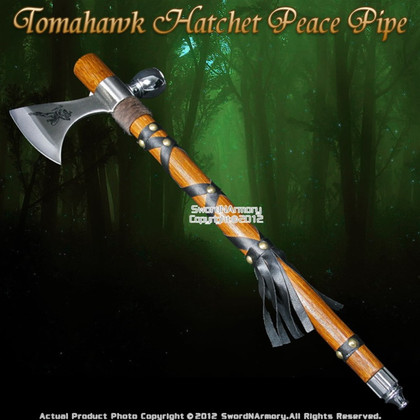A Brief History of the Cherokee Bone Tomahawk
Posted by Sword N Armory on Apr 12th 2020
The Algonquin People are credited with the invention of the ‘tomahawk’, though there’s now speculation that they may have engineered their version based on influence from Vikings lead by Leif Erikson. Viking axes were also used in battle and so had points on both ends as well as long handles. Regardless, over time the technology of the tomahawk spread down the coast, and soon the Cherokee had their own version of this lethal battle axe. Until the Europeans came over, tomahawks were usually made of wood and stone, or bone and stone. Though they are only really effective as a weapon, one of the most interesting uses of the tomahawk was as a pipe. The back end (which could have a spike) would be hollowed out for a bowl, and the stem of the pipe was the handle of the blade itself. Bone, being filled with marrow in the center to begin with, is ideal as a pipe. It can be hollowed out with ease.
As the Europeans brought metal, they appropriated tomahawk technology, and it became a standard-issue piece of military gear in America through 1812. Though tomahawks were used throughout the wars of the 20th century, for the most part they weren't standard issue and had to be purchased separately by military men. Though, throwing tomahawks and engaging in hand-to-hand combat with it have been taught by the American military. Still, modern day tomahawks are made out of steel in a single segment; and there's no pipe to be had anywhere. They're a far cry from the leather-wrapped bone-pipe Cherokee tomahawks of long ago, with their stone blades and ceremonial dressings. Though, even with the European introduction of metal, there was still a great deal of pipe use parleyed into Cherokee axe manufacture.
Today, there are a ubiquity of tomahawks in production. Certainly there are those of the modern tactical variety, but arguably more popular are authentic replicas of Cherokee bone tomahawks. These are often made as lovingly as their predecessors. Some can even be found fashioned by existing People of the Cherokee Nation today. These are necessarily going to be of the finest, most authentic quality. Additionally, there are organizations that produce them on a larger scale; but beyond weapons manufacturing, there is definitely something lost from that individual touch with which authentic Cherokee bone tomahawks are fashioned.
Since the Tomahawk was either a killing tool or a vice facilitation agent in its day, it has always held about it an aura of savage mystique. It’s one of the most iconic representations of Native American Warcraft commonly depicted. In fact, there were some Native Americans who refused to have their picture taken without their tomahawk pipes.
Bows, arrows, tomahawks--these things all evoke the image of the Native American Peoples. This evocation is to such a degree that often any tribe is depicted as using such traditional weapons, when in reality there were certainly tribes that had different means of defense. The 21st century audience can't really parse the difference, because the individuality of ancient Native American Peoples is often underplayed in academia. What may surprise many westerners to learn is that there are many Native American tribes who had religious practices that read like a translation of the Bible with tribal names describing major characters. (Take a trip down the flood legend path of ancient Native American tribes to see how true that is.) All of which demonstrates the difference in kind among these vast people. There were monotheistic (Great Spirit) and polytheistic tribes across the country; things weren't monochromatic. So even though the Cherokee bone tomahawk is one of the most iconic representations of pre-European culture on the North American continent, it isn't the single variation of traditional tomahawk available in either tradition or archaeological record.
There’s deep history in the Cherokee People, as well as the varying traditional weaponry and pipes they used in daily life. Perhaps one of the greatest reasons their bone tomahawk is still revered today has to do with the historical depth it cannot help but to evoke in anyone viewing it.










